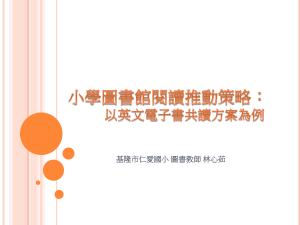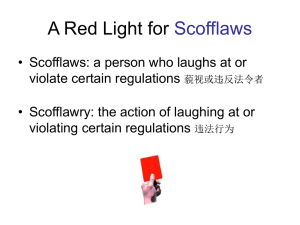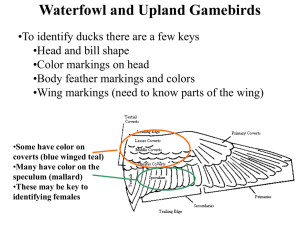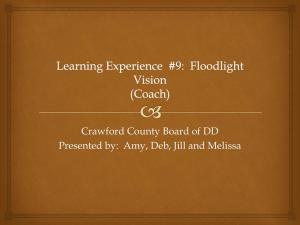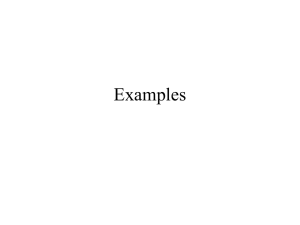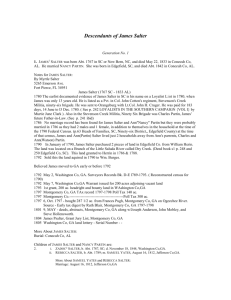36x72 poster template
advertisement
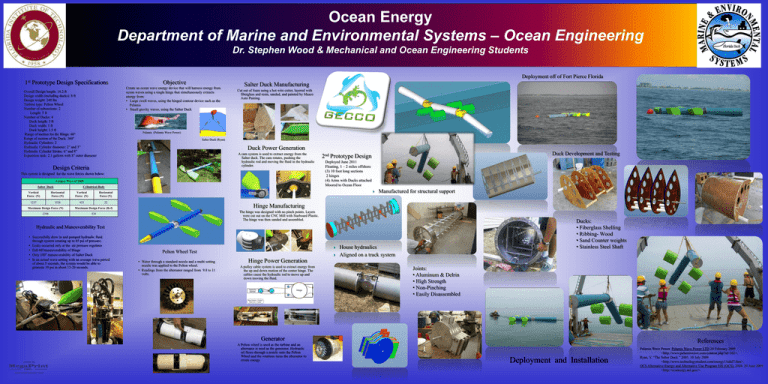
Ocean Energy Department of Marine and Environmental Systems – Ocean Engineering Dr. Stephen Wood & Mechanical and Ocean Engineering Students Deployment off of Fort Pierce Florida 1st Prototype Design Specifications Objective Create an ocean wave energy device that will harness energy from ocean waves using a single hinge that simultaneously extracts energy from: • Large swell waves, using the hinged contour device such as the Pelamis • Small gravity waves, using the Salter Duck Overall Design length: 14.2 ft Design width (including ducks): 8 ft Design weight: 240 lbs Turbine type: Pelton Wheel Number of subsections: 2 Length: 5 ft Number of Ducks: 4 Duck length: 3 ft Duck width: 1 ft Duck height: 1.5 ft Range of motion for the Hinge: 60° Range of motion of the Duck: 360° Hydraulic Cylinders: 2 Hydraulic Cylinder diameter: 2” and 3” Hydraulic Cylinder Stroke: 6” and 8” Expansion tank: 2.1 gallons with 8” outer diameter Salter Duck Manufacturing Cut out of foam using a hot wire cutter, layered with fiberglass and resin, sanded, and painted by Maaco Auto Paining. Pelamis (Pelamis Wave Power) Salter Duck (Ryan) Duck Power Generation A cam system is used to extract energy from the Salter duck. The cam rotates, pushing the hydraulic rod and moving the fluid in the hydraulic cylinder. Design Criteria This system is designed for the wave forces shown below: Largest Wave of 2008 Salter Duck Cylindrical Body Vertical Force (N) Horizontal Force (N) Vertical Force (N) Horizontal Force (N) 1237 1526 433 22 Maximum Design Force (N) Maximum Design Force (lb-f) 2398 539 Duck Development and Testing 2nd Prototype Design Deployed June 2011 Floating, 1 – 2 miles offshore (3) 10 foot long sections 2 hinges (4) Arms with Ducks attached Moored to Ocean Floor Manufactured for structural support Hinge Manufacturing The hinge was designed with no pinch points. Layers were cut out on the CNC Mill with Starboard Plastic. The hinge was then sanded and assembled. Ducks: • Fiberglass Shelling • Ribbing- Wood • Sand Counter weights • Stainless Steel Shaft Hydraulic and Maneuverability Test • Successfully drew in and pumped hydraulic fluid through system creating up to 45 psi of pressure. • Leaks occurred only at the air pressure regulator • Full 60°maneuverability of Hinge • Only 180° maneuverability of Salter Duck • In an actual wave setting with an average wave period of about 5 seconds, the system would be able to generate 10 psi in about 15-20 seconds. Pelton Wheel Test • Water through a standard nozzle and a multi setting nozzle was applied to the Pelton wheel. • Readings from the alternator ranged from 9.8 to 11 volts. House hydraulics Aligned on a track system Hinge Power Generation A pulley cable system is used to extract energy from the up and down motion of the center hinge. The cables cause the hydraulic rod to move up and down moving the fluid. Joints: • Aluminum & Delrin • High Strength • Non-Pinching • Easily Disassembled Generator printed by www.postersession.com A Pelton wheel is used as the turbine and an alternator is used as the generator. Hydraulic oil flows through a nozzle onto the Pelton Wheel and the rotations turns the alternator to create energy. References Deployment and Installation Pelamis Wave Power. Pelamis Wave Power LTD 20 February 2009 <http://www.pelamiswave.com/content.php?id=161>. Ryan, V. “The Salter Duck.” 2005. 10 July 2009 <http://www.technologystudent.com/energy1/tidal7.htm>. OCS Alternative Energy and Alternative Use Program EIS (OCS). 2008. 20 June 2009 <http://ocsenergy.anl.gov/>.

